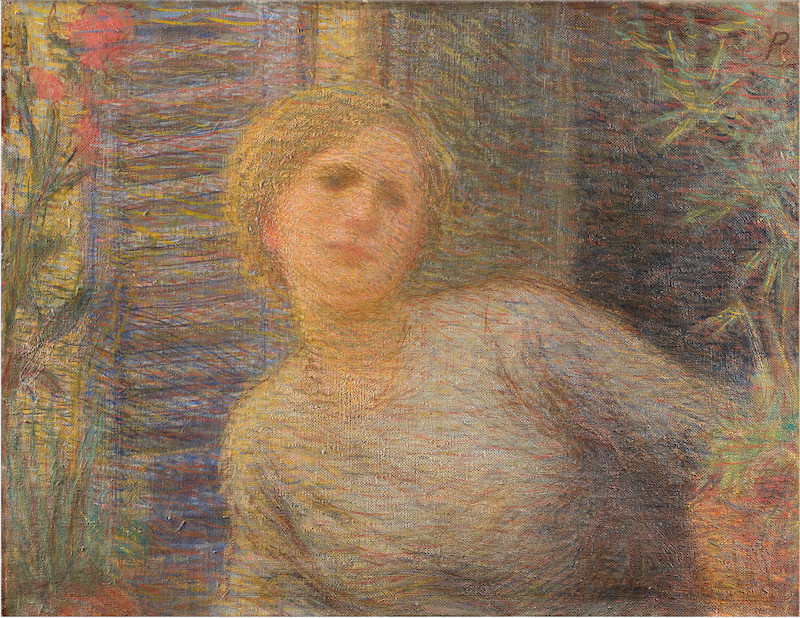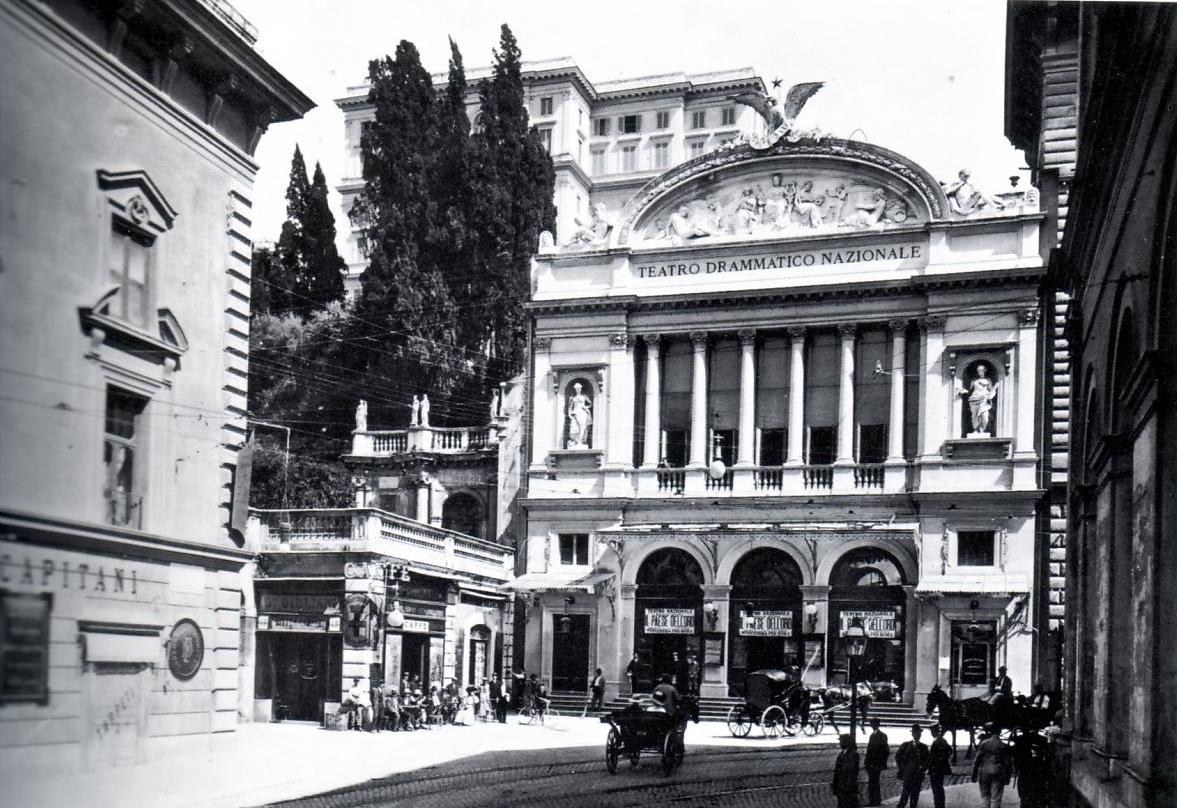|
Luigi De Servi
Luigi De Servi (4 June 1863 – 25 June 1945) was a French-Italian painter active mainly painting sacred subjects in a late-Mannerist style in Siena, Tuscany, Italy. Biography He was born in Lucca to a painter named Pietro de Servi. He left during the second year of gymnasium, despite his father's opposition, to enroll in the Regio Istituto di Belle Arti di Lucca, under the director Luigi Norcini. He first exhibited four works at the 29th Esposizione della Società Promotrice di Belle Artists in Genoa. In 1883, along with his eldest sister, a seamstress, he travelled to Argentina while twelve siblings remain in Lucca. He sold a number of works in Buenos Aires, and soon obtained commissions for portraits, signing "Luis De Servi". He enticed most of his siblings to move to Argentina. In 1884, he painted frescoes for the "Casa Rosada" in Buenos Aires. He also decorated the entrance rotonda, depicting the primitive life of the Argentines, of the Museo de La Plata. In 1886, he painted ... [...More Info...] [...Related Items...] OR: [Wikipedia] [Google] [Baidu] |
French People
The French people (french: Français) are an ethnic group and nation primarily located in Western Europe that share a common French culture, history, and language, identified with the country of France. The French people, especially the native speakers of langues d'oïl from northern and central France, are primarily the descendants of Gauls (including the Belgae) and Romans (or Gallo-Romans, western European Celtic and Italic peoples), as well as Germanic peoples such as the Franks, the Visigoths, the Suebi and the Burgundians who settled in Gaul from east of the Rhine after the fall of the Roman Empire, as well as various later waves of lower-level irregular migration that have continued to the present day. The Norse also settled in Normandy in the 10th century and contributed significantly to the ancestry of the Normans. Furthermore, regional ethnic minorities also exist within France that have distinct lineages, languages and cultures such as Bretons in Brittany, Occi ... [...More Info...] [...Related Items...] OR: [Wikipedia] [Google] [Baidu] |
Plinio Nomellini
Plinio Nomellini (1866–1943) was an Italian painter. Biography Nomellini was born in Livorno in 1866. In 1885 he enrolled at the Florence Academy of Fine Arts, where he studied under Giovanni Fattori and formed friendships with Telemaco Signorini and Silvestro Lega as well as Giuseppe Pellizza some time later. At the 1886 Promotrice of Florence, he exhibited a portrait and a landscape of ''Un uliveto''; at the 1887 Mostra he exhibited ''L'incontro'' and ''Piano di Tombolo''. In 1888, he exhibited a ''Portrait of Nina Van Zandt'' and ''Il fieno''. At the Mostra held at the Società d'Incoraggiamento of Florence he displayed the following paintings: ''Al sole''; ''Sciopero''; ''La giornata è finita (The Journey is Finished)''; ''Fiore selvaggio''; ''Foce del Calambrone'', and ''The Summer of San Martino''. [...More Info...] [...Related Items...] OR: [Wikipedia] [Google] [Baidu] |
Argentine Painters
Argentines (mistakenly translated Argentineans in the past; in Spanish (masculine) or (feminine)) are people identified with the country of Argentina. This connection may be residential, legal, historical or cultural. For most Argentines, several (or all) of these connections exist and are collectively the source of their being ''Argentine''. Argentina is a multiethnic and multilingual society, home to people of various ethnic, religious, and national origins, with the majority of the population made up of Old World immigrants and their descendants. As a result, Argentines do not equate their nationality with ethnicity, but with citizenship and allegiance to Argentina. Aside from the indigenous population, nearly all Argentines or their ancestors immigrated within the past five centuries. Among countries in the world that have received the most immigrants in modern history, Argentina, with 6.6 million, ranks second to the United States (27 million), and ahead of other immigr ... [...More Info...] [...Related Items...] OR: [Wikipedia] [Google] [Baidu] |
Italian Male Painters
Italian(s) may refer to: * Anything of, from, or related to the people of Italy over the centuries ** Italians, an ethnic group or simply a citizen of the Italian Republic or Italian Kingdom ** Italian language, a Romance language *** Regional Italian, regional variants of the Italian language ** Languages of Italy, languages and dialects spoken in Italy ** Italian culture, cultural features of Italy ** Italian cuisine, traditional foods ** Folklore of Italy, the folklore and urban legends of Italy ** Mythology of Italy, traditional religion and beliefs Other uses * Italian dressing, a vinaigrette-type salad dressing or marinade * Italian or Italian-A, alternative names for the Ping-Pong virus, an extinct computer virus See also * * * Italia (other) * Italic (other) * Italo (other) * The Italian (other) * Italian people (other) Italian people may refer to: * in terms of ethnicity: all ethnic Italians, in and outside of Italy * ... [...More Info...] [...Related Items...] OR: [Wikipedia] [Google] [Baidu] |
19th-century Italian Painters
The 19th (nineteenth) century began on 1 January 1801 ( MDCCCI), and ended on 31 December 1900 ( MCM). The 19th century was the ninth century of the 2nd millennium. The 19th century was characterized by vast social upheaval. Slavery was abolished in much of Europe and the Americas. The First Industrial Revolution, though it began in the late 18th century, expanding beyond its British homeland for the first time during this century, particularly remaking the economies and societies of the Low Countries, the Rhineland, Northern Italy, and the Northeastern United States. A few decades later, the Second Industrial Revolution led to ever more massive urbanization and much higher levels of productivity, profit, and prosperity, a pattern that continued into the 20th century. The Islamic gunpowder empires fell into decline and European imperialism brought much of South Asia, Southeast Asia, and almost all of Africa under colonial rule. It was also marked by the collapse of the large ... [...More Info...] [...Related Items...] OR: [Wikipedia] [Google] [Baidu] |
1945 Deaths
1945 marked the end of World War II and the fall of Nazi Germany and the Empire of Japan. It is also the only year in which Nuclear weapon, nuclear weapons Atomic bombings of Hiroshima and Nagasaki, have been used in combat. Events Below, the events of World War II have the "WWII" prefix. January * January 1 – WWII: ** Nazi Germany, Germany begins Operation Bodenplatte, an attempt by the ''Luftwaffe'' to cripple Allies of World War II, Allied air forces in the Low Countries. ** Chenogne massacre: German prisoners are allegedly killed by American forces near the village of Chenogne, Belgium. * January 6 – WWII: A German offensive recaptures Esztergom, Kingdom of Hungary (1920–1946), Hungary from the Russians. * January 12 – WWII: The Soviet Union begins the Vistula–Oder Offensive in Eastern Europe, against the German Army (Wehrmacht), German Army. * January 13 – WWII: The Soviet Union begins the East Prussian Offensive, to eliminate German forces in East Pruss ... [...More Info...] [...Related Items...] OR: [Wikipedia] [Google] [Baidu] |
1863 Births
Events January–March * January 1 – Abraham Lincoln signs the Emancipation Proclamation during the third year of the American Civil War, making the abolition of slavery in the Confederate states an official war goal. It proclaims the freedom of 3.1 million of the nation's four million slaves and immediately frees 50,000 of them, with the rest freed as Union armies advance. * January 2 – Lucius Tar Painting Master Company (''Teerfarbenfabrik Meirter Lucius''), predecessor of Hoechst, as a worldwide chemical manufacturing brand, founded in a suburb of Frankfurt am Main, Germany. * January 4 – The New Apostolic Church, a Christian and chiliastic church, is established in Hamburg, Germany. * January 7 – In the Swiss canton of Ticino, the village of Bedretto is partly destroyed and 29 killed, by an avalanche. * January 8 ** The Yorkshire County Cricket Club is founded at the Adelphi Hotel, in Sheffield, England. ** American Civil War – ... [...More Info...] [...Related Items...] OR: [Wikipedia] [Google] [Baidu] |
Palazzo Rosso, Genoa
The Palazzo Brignole Sale or Palazzo Rosso is a house museum located in Via Garibaldi, in the historical center of Genoa, in Northwestern Italy. The palace is part of the UNESCO World Heritage Site Genoa: Le Strade Nuove and the system of the Palazzi dei Rolli. The rich art collection inside, along with the galleries of Palazzo Bianco and Palazzo Doria Tursi, is part of the Musei di Strada Nuova and consists of the works of artists of the caliber of Antoon van Dyck, Guido Reni, Paolo Veronese, Guercino, Gregorio De Ferrari, Albrecht Dürer, Bernardo Strozzi and Mattia Preti. History Built in 1675, Palazzo Rosso was not one of the 163 Palazzi dei Rolli of Genoa, the selected private residences where the notable guests of the Republic of Genoa were hosted during State visits, as the last of such list was completed in 1664, ten years before the construction of the palace. As a distinguished 17th-century palace in ''Strada Nuova'', however, on 13 luglio del 2006 it was incl ... [...More Info...] [...Related Items...] OR: [Wikipedia] [Google] [Baidu] |
National Dramatic Theatre
The National Dramatic Theatre or National Theatre was a theatre Theatre or theater is a collaborative form of performing art that uses live performers, usually actors or actresses, to present the experience of a real or imagined event before a live audience in a specific place, often a stage. The perform ... in Rome, now demolished to build Via Nazionale. History Bibliography *Stefania Severi ''I teatri di Roma'', Roma, Newton & Compton, 1989. {{Coord missing, Italy Theatres in Rome ... [...More Info...] [...Related Items...] OR: [Wikipedia] [Google] [Baidu] |
Mussolini
Benito Amilcare Andrea Mussolini (; 29 July 188328 April 1945) was an Italian politician and journalist who founded and led the National Fascist Party. He was Prime Minister of Italy from the March on Rome in 1922 until his deposition in 1943, and "Duce" of Italian Fascism from the establishment of the Italian Fasces of Combat in 1919 until his execution in 1945 by Italian partisans. As dictator of Italy and principal founder of fascism, Mussolini inspired and supported the international spread of fascist movements during the inter-war period. Mussolini was originally a socialist politician and a journalist at the ''Avanti!'' newspaper. In 1912, he became a member of the National Directorate of the Italian Socialist Party (PSI), but he was expelled from the PSI for advocating military intervention in World War I, in opposition to the party's stance on neutrality. In 1914, Mussolini founded a new journal, ''Il Popolo d'Italia'', and served in the Royal Italian Army during ... [...More Info...] [...Related Items...] OR: [Wikipedia] [Google] [Baidu] |
Viareggio
Viareggio () is a city and ''comune'' in northern Tuscany, Italy, on the coast of the Tyrrhenian Sea. With a population of over 62,000, it is the second largest city within the province of Lucca, after Lucca. It is known as a seaside resort as well as being the home of the famous carnival of Viareggio (dating back to 1873), and its papier-mâché floats, which (since 1925), parade along the promenade known as "Passeggiata a mare", in the weeks of Carnival. The symbol of the carnival of Viareggio and its official mask is Burlamacco, designed and invented by Uberto Bonetti in 1930. The city traces its roots back to the first half of the 16th century when it became the only gate to the sea for the Republic of Lucca. The oldest building in Viareggio, known as Torre Matilde, dates back to this time and was built by the Lucchesi in 1541 as a defensive fortification to fight the constant menace of corsair incursions. Viareggio is also an active industrial and manufacturing centre; ... [...More Info...] [...Related Items...] OR: [Wikipedia] [Google] [Baidu] |




